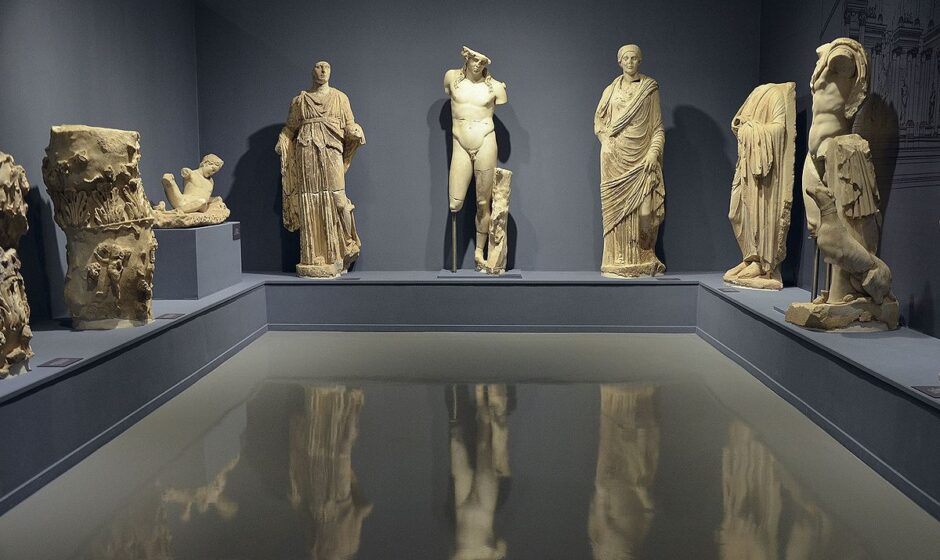Ephesus Museum, Ephesus and nearby Mycenaean, Archaic, Classical, Hellenistic, Roman, Byzantine, Seljuk, and Ottoman-era beside important works. Since the Ephesus Museum is predominantly a museum exhibiting the works of an ancient city, it prefers to display the works according to the find locations instead of a chronological and typological exhibition. Yamaç Houses and House Finds Hall, Coins and Treasury Section, Grave Finds Hall, Ephesus Artemisi Hall, Emperor Cult Hall. In addition to these halls, various architectural and sculptural works are exhibited in garden decoration and harmoniously.
Two large Artemis statues, Eros head, Yunuslu Eros figurine, Socrates’ head are the world-famous famous works of Ephesus Museum. There are still approximately 64,000 works in the collections of Ephesus Museum. It increases with works and museum collections are enriched. With the thought of creating a “New Finds Hall” in the Ephesus Museum, these works are presented to the service of the scientific world and humanity in a short time. However, this hall is not always sufficient, it should be renewed in the light of new finds in rechargeable salons, and in accordance with the contemporary museum understanding.
In accordance with this understanding, in the new arrangement made in Yamaç Houses and House Findings Hall, by exhibiting the finds groups together, some of the medical and cosmetic tools, jewelry, weights, enlightenment tools, music, and entertainment find and weaving tools within the subject of daily life; statuettes, emperor and god statues, busts and furniture are on display. A room known as “Socrates Room” from Efes Yamaç Houses in a room of the hall is arranged with photo mannequins in its decor consisting of frescoes, mosaics, and various furniture.
The new sections of the Museum opened to visitors as a result of new arrangements in the museum, Ephesus, and Selcuk;
1- Arasta and Hamam Section: In the section adjacent to the middle garden of themuseum, which forms integrity with the museum, commercial life and various handicrafts that are lost in the old Turkish towns are exhibited live. With the development and different types of grain grinding system; mills which have an important place in local life related to agriculture; coppersmith and eye bead making; In the section where the Turkish tents are exhibited, the old Turkish structure and the Ottoman bath belonging to the 16th century were also restored and evaluated in the exhibition area.
2- Ayasuluk Library: An old Turkish structure (14th century) in the back street of the Ephesus Museum was restored by the museum and a small library function was provided for the people of the district to read daily newspapers or books.
3- Museum for the Visually Impaired: One of the ancient shops in Ephesus’ lower agora was restored and turned into a museum for the visually impaired. In this museum, which consists of two sections, copy and original works are exhibited.
Excursions to Ephesus From Izmir
How do we do Excursions to Ephesus from Izmir?
We started the day early in the morning. On our website (gezenthings.com) we have several opportunities to participate in the Ephesus Tour. If you want to visit the ancient city of Ephesus only, click on this link to get there. We also have some excursions to Ephesus from Izmir, mixes. Like Ephesus + Artemis Temple + House of Virgin Mary or Ephesus + House of Virgin Mary + Typical Town ….
What is there to visit around Ephesus? Izmir city supports various towns in the city. One of these towns is called Selcuk. In the village of Selcuk, we can find the ancient city of Ephesus, the Temple of Artemis, the House of Santa Maria, the Isa Bey Mosque, the Basilica of Saint John, the typical town of Sirince, the Museum of Ephesus.
Since 2015; The city of Ephesus, The House of Saint Mary, The Cave of the Seven Sleepers, The Basilica of Saint John, The Artemis Temple are on the UNESCO list;
(UNESCO World Heritage) When you see this symbol it means that the place is on thislist.
In the city of Ephesus, we have 2 entrances. One lower and the other on higher ground. The high gate is called The Gate of Magnesia. Returning to this gate, the city is inclined towards the low door. For this reason, we chose to start the tours to Ephesus from Izmir through this gate. By this gate you can visit all the important places and go out from the lower door. The visit of the city varies between 1.5 hours to a few hours according to the level of interest of the guests.




